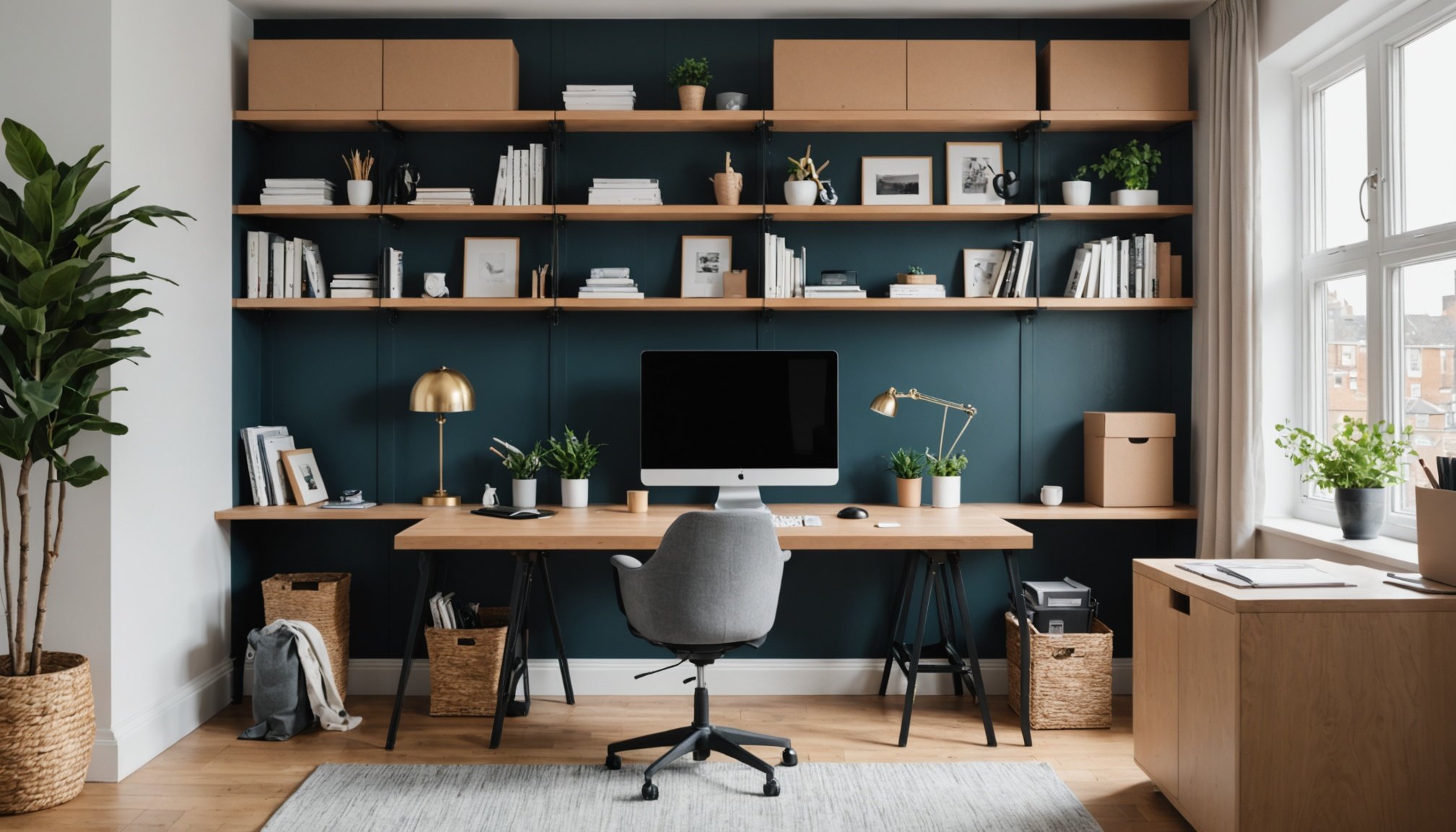Planning Your Home Office Relocation
Organising a home office move can be overwhelming, but with the right approach, it can proceed smoothly. Begin by establishing a clear timeline for your relocation process. This timeline is essential to keep your relocation organised and allow you to address each part of the move efficiently, avoiding last-minute rushes that could cause mistakes or damage to your equipment.
Before the move, take time to assess your current setup. This involves evaluating which components of your home office need to be relocated and determining if you require any new elements for your UK home office setup. Consider the essential furniture and equipment you use daily and note any items that are no longer useful or suited to your new office space.
A voir aussi : Maximize Your Move: Smart Ways to Use Modular Storage Units During a Staggered Relocation in the UK
Researching local services can significantly ease the logistics of the move. In the UK, there are numerous services specifically geared towards home office relocations. These services may include professional movers, IT setup assistance, and interior design consultants to optimise your new workspace. Enlisting these professionals can save time and reduce stress.
By creating a structured plan and utilising these home office moving tips, you can streamline your relocation, ensuring a seamless transition to your new workspace.
A découvrir également : Unlocking Advantages: Why Moving in Off-Peak Seasons in the UK is a Smart Choice
Packing Strategies for Home Office Equipment
Moving office equipment requires smart packing tips and strategic organization techniques to ensure everything remains safe and accessible. Start by categorising your items: computers, cables, stationery, and essential documents. Begin by sorting them into logical groups. This office equipment safety measure helps when unpacking, making everything accessible.
Label each box with both the contents and the room it belongs to. This aids movers and helps ensure essential items are easy to locate upon arrival. Use terms like “FRAGILE” where necessary to highlight delicate items. Protecting fragile equipment is crucial—wrap these items in bubble wrap or foam padding to buffer any impacts during transit.
For efficiency, enlist the “packing essentials last” technique. This involves boxing up vital equipment last, ensuring they are among the first off the van. Computers and essential documents should be packed last yet strategically placed for quick access. This reduces downtime, allowing you to settle into your new office seamlessly.
Finally, consider using durable boxes and containers to avoid damage. Investing in proper materials contributes heavily to both the safety and organization of your move. Implementing these tips can transform the chaotic packing phase into a structured and efficient operation.
Essential Tools for a Smooth Transition
Moving can be a daunting task, but with the right relocation tools, you can ensure transition efficiency while maintaining high levels of productivity. Having the proper tools and equipment is essential to make the process as seamless as possible.
Must-Have Packing Supplies
When packing your home office, prioritize securing your equipment with quality packing supplies. Consider using:
- Sturdy boxes: Opt for those specifically designed for electronics.
- Bubble wrap and packing paper: These essentials provide excellent protection for fragile items.
- Cable organizers: To prevent tangling and ensure orderly unpacking.
These supplies ensure that your items remain intact and organized, minimizing disruptions to your workflow.
Technology and Setup Essentials
Maintaining productivity during a move requires thoughtful planning. Essential tech tools include:
- A portable Wi-Fi hotspot to stay connected.
- External hard drives for critical data backups.
- Power strips and surge protectors to easily set up anywhere.
These essentials keep your digital tasks on track and limit downtime during your relocation.
Moving Equipment Recommendations
To facilitate a smoother transition, utilize reliable moving equipment. Items like dollies and furniture sliders are invaluable in preventing strain and injury. A label maker can also be a significant time-saver, helping you categorize and track items swiftly.
Setting Up Your New Home Office
Creating a home office that enhances productivity and comfort is essential to your work success. Start with workspace ergonomics: select a chair that provides adequate support for your back and a desk at the right height to avoid strain. Position your computer screen at eye level to prevent neck discomfort. Arrange your equipment and supplies within easy reach to reduce unnecessary stretching and twisting.
An optimal office layout can significantly impact productivity. Consider a desk that faces a window or an open space to benefit from natural light, which can enhance mood and energy levels. If possible, dedicate a corner that minimizes distractions, helping you focus better. Utilize shelves or filing cabinets to organize documents, thereby maintaining a tidy, efficient workspace.
Personalizing your office adds a touch of inspiration to the environment. Include elements such as plants, artwork, or motivational quotes that foster creativity and make the space uniquely yours. Not only does this make the office more inviting, but it also helps create a positive mindset.
By focusing on these fundamentals—ergonomics, new office layout, and personalized touches—you’ll be well on your way to designing a home office that promotes both health and productivity.
The Importance of Internet Setup
Relocating to a new office often involves numerous logistical challenges, not least of which is ensuring a reliable internet setup. A clear plan focused on connectivity is essential when orchestrating this aspect of your move.
Start by listing the steps to maintain uninterrupted connectivity. Evaluate available local service providers to find the best fit. In the UK, the market boasts a variety of service providers, each offering different levels of service and pricing. Comparing these options thoroughly is vital, ideally before your move. Assess factors including speed, customer support, and contract terms. This initial preparation can significantly impact your overall internet experience.
Minimizing downtime during the transition is crucial for business continuity. Coordinated internet installation can be a game-changer in achieving this objective. Collaborate with your chosen service provider to schedule installation at a time that overlaps minimally with business hours. Planning ahead will reduce the risk of protracted service interruptions, ensuring a smoother transition.
Focusing on these aspects not only promotes seamless connectivity but also fosters productivity and efficiency in your new office. Remember to communicate clearly with your team about any temporary disruptions to manage expectations effectively. Thus, approaching your internet setup with careful consideration and informed decision-making will provide long-term benefits.
Psychological Aspects of Moving Your Workspace
Relocating a workspace involves more than just physical adjustments; it taps into workplace transition psychology to effectively tackle emotional shifts. Stress and anxiety are common during such transitions, making emotional adjustment crucial.
Coping Strategies: Addressing emotional stress begins with acknowledging your feelings. It’s beneficial to adopt coping strategies tailored to workplace transition psychology. These might include creating a list of tasks to ensure nothing gets overlooked, or practicing mindfulness to stay grounded. Journaling is another method that offers insights into personal thoughts and assists in managing emotions effectively.
Calming Workspace: Once you’ve settled your belongings, focusing on creating a calming workspace can significantly enhance productivity. This might involve using calming colors, incorporating plants to bring a touch of nature, or adding personal mementos that foster a sense of belonging. These steps are integral to maintaining focus and reducing workplace anxiety.
Transition Routine: Establishing a consistent transition routine is key to comfortably settling into your new environment. Daily rituals, such as starting the day with focused breathing exercises, can help maintain focus and provide stability. A clear routine supports emotional adjustment and cultivates a sense of control over the new setting.
Localized Resources and Services in the UK
Are you planning a UK home office relocation? A variety of specialized services are available to ease your transition. These services take the hassle out of moving and ensure that your office setup is ready to go in your new location. One popular choice is to employ local movers. They offer tailored solutions, handling everything from delicate electronics to bulky furniture with expertise.
Finding the right specialized movers for office equipment is crucial. Such movers have the necessary experience and equipment to safely transport sensitive items like computers and printers. They also provide insurance options to protect against potential damages during the move.
To locate reliable services, leverage resource websites and directories that focus on relocation assistance. These platforms provide valuable information, including reviews and ratings of different companies, helping you to select a service provider that meets your needs. Additionally, they offer guides on planning your move, ensuring you don’t overlook any important steps.
Seeking out these resources not only simplifies the moving process but also provides peace of mind knowing that your home office will be operational and efficient from day one in its new location.












